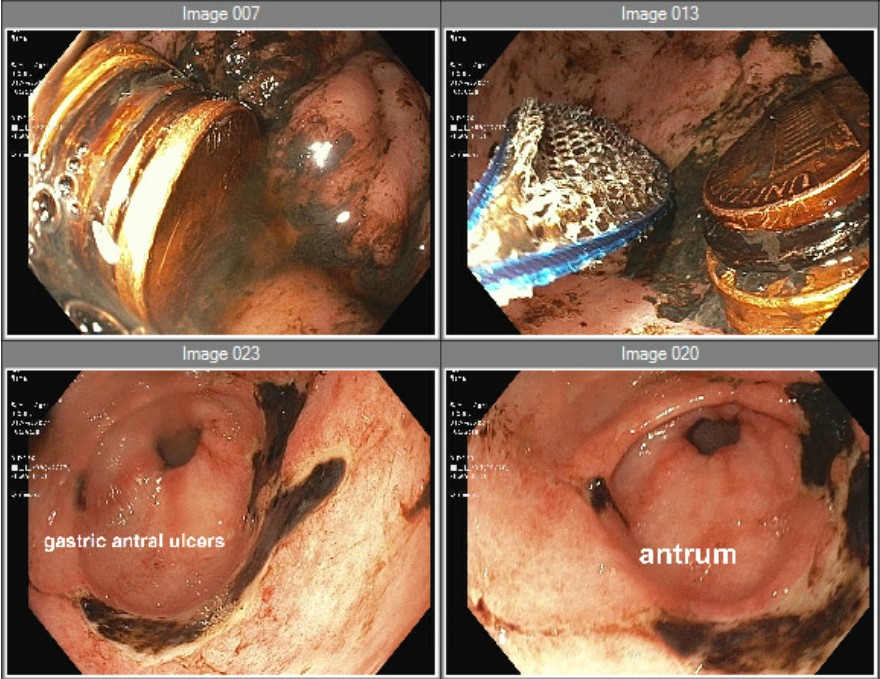Sunday Poster Session
Category: Stomach and Spleen
P2075 - When Cents Harm: A Case of Penny Ingestion Causing Gastric Ulcer and Prolonged Retention in an Adult
Sunday, October 26, 2025
3:30 PM - 7:00 PM PDT
Location: Exhibit Hall

Abdulrahman Atasi, MD (he/him/his)
One Brooklyn Health-Brookdale University Hospital Medical Center
Brooklyn, NY
Presenting Author(s)
Abdulrahman Atasi, MD1, Omar Oudit, DO2, Iyad Y. Idries, MD1, Mohamad Alabdallat, MD1, Yasir Ali, MD1, Nader Daoud, MD2, Derrick Cheung, MD2
1One Brooklyn Health-Brookdale University Hospital Medical Center, Brooklyn, NY; 2Brookdale University Hospital Medical Center, Brooklyn, NY
Introduction: Foreign body ingestion predominantly affects the pediatric population, with coins being among the most frequently ingested objects. Adult cases are uncommon. While most ingested foreign bodies pass spontaneously through the gastrointestinal tract, complications can include mucosal erosion, perforation, and obstruction.
Case Description/
Methods: A 64-year-old female with a past medical history of substance abuse presented with altered mental status, decreased responsiveness, abdominal distention, and vomiting, she was admitted to the medical intensive care unit for management of toxic metabolic encephalopathy. Initial imaging (chest x-ray and computed tomography of the chest) revealed multiple metallic circular foreign bodies in the thoracic region, persisting for three days on imaging. Esophagogastroduodenoscopy revealed a stack of six pennies in the proximal gastric antrum, successfully retrieved using a roth net. Additionally, it showed two clean-based antral ulcers (3cm and 1cm) with overlying eschar and antral gastritis. Gross examination showed six one-cents with 1.9 cm diameter. Histopathologic examination of gastric biopsies demonstrated mild chronic inflammation with positive Helicobacter pylori staining in the antrum. Later on during hospitalization imaging showed an incidental finding of metallic density in the right pelvis without clinical evidence of bowel obstruction. The patient received multiple sessions of polyethylene glycol as conservative management, then although colonoscopy was planned, the retained penny passed spontaneously. The hospital course was complicated by HSV encephalitis, seizures requiring multiple antiepileptic drugs, ventilator associated pneumonia, prolonged intubation requiring tracheostomy.
Discussion: This case illustrates several aspects of management of foreign body ingestion in an adult. The development of gastric ulceration in the antrum is likely multifactorial from mechanical trauma and prolonged mucosal contact in the setting of Helicobacter pylori. It also shows successful conservative management with polyethylene glycol for prolonged foreign bodies retention in the bowels, while the patient was being planned for colonoscopy which was delayed as the patient had no signs of bowel obstruction and intervention was deemed high-risk given the patient's critical condition and concerns of active infection.

Figure: Images from Esophagogastroduodenoscopy shows stack of coins being removed with roth net and underlying antral ulcer

Figure: A: Chest radiograph on the day of arrival shows 2 rounded radiopaque foreign bodies lodged in the esophagus
B-D: Serial abdominal radiographs demonstrate progression of the ingested radiopaque foreign bodies, initially located in the right lower quadrant, to their complete passage from the gastrointestinal tract.
Disclosures:
Abdulrahman Atasi indicated no relevant financial relationships.
Omar Oudit indicated no relevant financial relationships.
Iyad Y. Idries indicated no relevant financial relationships.
Mohamad Alabdallat indicated no relevant financial relationships.
Yasir Ali indicated no relevant financial relationships.
Nader Daoud indicated no relevant financial relationships.
Derrick Cheung indicated no relevant financial relationships.
Abdulrahman Atasi, MD1, Omar Oudit, DO2, Iyad Y. Idries, MD1, Mohamad Alabdallat, MD1, Yasir Ali, MD1, Nader Daoud, MD2, Derrick Cheung, MD2. P2075 - When Cents Harm: A Case of Penny Ingestion Causing Gastric Ulcer and Prolonged Retention in an Adult, ACG 2025 Annual Scientific Meeting Abstracts. Phoenix, AZ: American College of Gastroenterology.
1One Brooklyn Health-Brookdale University Hospital Medical Center, Brooklyn, NY; 2Brookdale University Hospital Medical Center, Brooklyn, NY
Introduction: Foreign body ingestion predominantly affects the pediatric population, with coins being among the most frequently ingested objects. Adult cases are uncommon. While most ingested foreign bodies pass spontaneously through the gastrointestinal tract, complications can include mucosal erosion, perforation, and obstruction.
Case Description/
Methods: A 64-year-old female with a past medical history of substance abuse presented with altered mental status, decreased responsiveness, abdominal distention, and vomiting, she was admitted to the medical intensive care unit for management of toxic metabolic encephalopathy. Initial imaging (chest x-ray and computed tomography of the chest) revealed multiple metallic circular foreign bodies in the thoracic region, persisting for three days on imaging. Esophagogastroduodenoscopy revealed a stack of six pennies in the proximal gastric antrum, successfully retrieved using a roth net. Additionally, it showed two clean-based antral ulcers (3cm and 1cm) with overlying eschar and antral gastritis. Gross examination showed six one-cents with 1.9 cm diameter. Histopathologic examination of gastric biopsies demonstrated mild chronic inflammation with positive Helicobacter pylori staining in the antrum. Later on during hospitalization imaging showed an incidental finding of metallic density in the right pelvis without clinical evidence of bowel obstruction. The patient received multiple sessions of polyethylene glycol as conservative management, then although colonoscopy was planned, the retained penny passed spontaneously. The hospital course was complicated by HSV encephalitis, seizures requiring multiple antiepileptic drugs, ventilator associated pneumonia, prolonged intubation requiring tracheostomy.
Discussion: This case illustrates several aspects of management of foreign body ingestion in an adult. The development of gastric ulceration in the antrum is likely multifactorial from mechanical trauma and prolonged mucosal contact in the setting of Helicobacter pylori. It also shows successful conservative management with polyethylene glycol for prolonged foreign bodies retention in the bowels, while the patient was being planned for colonoscopy which was delayed as the patient had no signs of bowel obstruction and intervention was deemed high-risk given the patient's critical condition and concerns of active infection.

Figure: Images from Esophagogastroduodenoscopy shows stack of coins being removed with roth net and underlying antral ulcer

Figure: A: Chest radiograph on the day of arrival shows 2 rounded radiopaque foreign bodies lodged in the esophagus
B-D: Serial abdominal radiographs demonstrate progression of the ingested radiopaque foreign bodies, initially located in the right lower quadrant, to their complete passage from the gastrointestinal tract.
Disclosures:
Abdulrahman Atasi indicated no relevant financial relationships.
Omar Oudit indicated no relevant financial relationships.
Iyad Y. Idries indicated no relevant financial relationships.
Mohamad Alabdallat indicated no relevant financial relationships.
Yasir Ali indicated no relevant financial relationships.
Nader Daoud indicated no relevant financial relationships.
Derrick Cheung indicated no relevant financial relationships.
Abdulrahman Atasi, MD1, Omar Oudit, DO2, Iyad Y. Idries, MD1, Mohamad Alabdallat, MD1, Yasir Ali, MD1, Nader Daoud, MD2, Derrick Cheung, MD2. P2075 - When Cents Harm: A Case of Penny Ingestion Causing Gastric Ulcer and Prolonged Retention in an Adult, ACG 2025 Annual Scientific Meeting Abstracts. Phoenix, AZ: American College of Gastroenterology.
